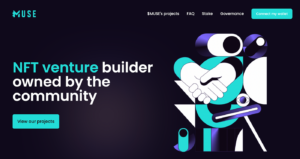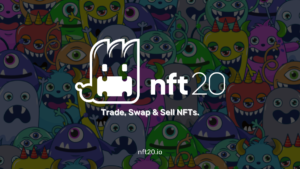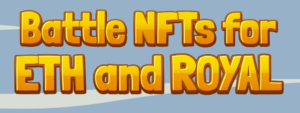
Since before the conversion of $Muse token from social to governance token (late 2020/ early 2021). The writer has held an interest in the development and social structure of the $Muse token. Much thanks is due to both of the developers. For their continued willingness to answer my many questions for comment, from a layman perspective as well as a persistent consent to engage at all, no matter how busy they are with their many and varied projects.
NFTs (Non-Fungible Tokens) and DeFi (Decentralized Finance) are two of the most exciting trends in the cryptocurrency world. NFTs, particularly in the context of gaming, offer unique, irreplaceable, and often tradable assets that can have both in-game and real-world value. DeFi, on the other hand, has created a decentralized financial system that runs on smart contracts, offering a range of services like loans, insurance, and asset trading without the need for traditional institutions.
It’s common for experimental projects to morph or adapt to new paradigms quickly. Early projects often serve as “proofs of concept,” demonstrating the feasibility of a given idea but also highlighting limitations and challenges. Subsequent iterations or projects then adopt these learnings, adapting and improving in the process. To use the Motto of The Round Table (Thought by me to be from Monty Python) they seek to “Adopt, adapt and improve”.
A brief, not exclusive overview of just some of the projects to date:
Very Nifty –

VeryNifty emerged as an innovative force within the blockchain universe, transforming the way we perceive Non-Fungible Tokens (NFTs). The platform offered far more than the average NFT marketplaces; it enabled you to wrap your existing NFTs into new, dynamic forms called vNFTs, leading to daily rewards and intense leaderboard competition. Here’s a deep dive into this captivating ecosystem.
Wrapping your NFT into a vNFT was just the beginning. Once created, your vNFT generated MUSE tokens (ERC-20) on a daily basis. The operation was simple: click the ‘Claim Rewards’ button, and the freshly minted MUSE was transferred to your account. This MUSE was then invested back into the ecosystem in a fascinating way—buying gems to ascend the leaderboard.
However, there was a catch. Fail to invest in gems for several consecutive days, and your vNFT would suffer the ultimate fate—it would die, get burned, and cease its MUSE-generating ability. Adding a layer of urgency and strategy, making your involvement crucial for your vNFT’s survival.
Being an active participant, at the time ETH 1 gas fees would, at times come in at over $100 usd. Layering yet another, probably unforeseen level of strategy. vNFT became, for some, very much a labor of love. On the writer’s final mine, from memory 15 odd $Muse were claimed. At the time worth approximately 50c a piece. Love and loyalty to one’s pet was returned many times. With an ATH of circa $120 in Feb 2021.
The mechanics of VeryNifty were not only engaging, but evident of developers’ commitment to fair and open token distribution. With plans to transition from a social to a DAO token model. Making it evident that inclusivity and decentralization were a core value.
NFT20 –

NFT20, launched in September 2020 was launched by and before NFX (launched January 2021).
“Trade, swap & sell NFTs. The NFT20 protocol offers NFT liquidity pools to help developers build the next generation of NFT apps”
When discussing NFT marketplaces, one term rarely associated with them is “liquidity.” Yet, NFT20 had not just ventured into this unexplored terrain but has also set pioneering standards for others to follow. Well ahead of the curve, this platform has achieved what was once considered unattainable—offering liquidity in exchange for NFTs.
Community-driven to its core, NFT20 allows projects to set their floor prices. The concept of floor prices is crucial in the NFT space as it determines the minimum value at which an NFT can be sold. By enabling projects to establish their floor prices, the platform has returned the power to the community, ensuring that market dynamics are decided by the very people who engage with it most.
Offering these groundbreaking features, NFT20 became the forerunner for countless other projects, many of which have become household names in the crypto community. The platform’s novel approaches to liquidity, community participation, and token economics have set the bar high for upcoming projects seeking to disrupt the NFT space. In the writer’s opinion, VeryNifty’s trailblazing initiatives are not mere flash-in-the-pan experiments but the foundation for a long list of future innovations in the crypto and NFT space.
Battle Royal –

A “winner-takes-all” variation of vNFTs, Battle Royal ratcheted up the stakes, and the competition, to a whole new level. Case in point, the staggering prize of 10.23 ETH was claimed by the lucky winner.
While the fundamental elements of vNFT remained, such as wrapping NFTs, earning $Royal (rather than $Muse) tokens, and purchasing gems, Battle Royal introduced an entirely new variable into the mix—defense. Unlike the standard vNFT mechanism, focussing primarily on accumulation and growth, Battle Royal demanded a more strategic balance between offense and defense. Layering complexity and excitement to the user experience.
Cudl Finance –

In the ever-changing landscape of blockchain games and tokens, Cudl holds a unique and emotional significance for many. An epitome of ‘right place, right time,’ the $Cudl token once soared to an All-Time High (ATH) of approximately $220 per token before even making its way to CoinMarketCap or CoinGecko. Originating as an Ethereum Layer 1 (ETH L1) game, its transformation over time reveals a narrative rich in innovation, challenges, and resilience.
Initially, the Cudl ecosystem was all about Mooncats—unique, collectible creatures that had to be wrapped and brought into the game. Players fed, maintained, and mined their live Mooncat pets to yield ERC20 tokens, turning the experience into a real Ethereum-spinner. But like any evolving system, it had its pitfalls. The crippling ETH L1 fees and a regrettable exploit forced the game into a temporary pause.
In response to the soaring ETH L1 fees and vulnerabilities, the team made a decisive move to transition the game to Arbitrum, an Optimistic Rollup Layer 2 solution. The migration wasn’t merely technical but also conceptual. Mooncats, which had become hot-selling items at Christie’s auctions, were replaced with in-house designed $Cudl cats to lower the entry barrier for new players. In addition, the game introduced “Bizarre” items and the benefits of reduced fees courtesy of the Arbitrum sidechain.
Today, new pets are available for 0.1 ETH per life, and the game continues to engage its community, while also offering a fertile ground for developers to contribute. With the freedom to modify and build upon the existing infrastructure, Cudl promises to be an ongoing experiment in decentralized gaming and community involvement.
The White Lotus –



The White Lotus ($LOTUS) wasn’t just another token entering the crypto market; A proof-of-concept aimed at solving one of the most vexing issues in tokenomics: the tendency of most tokens to lose value over time relative to Ethereum (ETH). The project promessing to offer a novel cooperative structure centered around an automatic market-making algorithm. Here’s a closer look at this intriguing initiative.
What Sets $LOTUS Apart?
Unlike DAO or governance tokens, $LOTUS positions as a cooperative. A cooperative is a collectively owned organization where the benefits are shared among members. Leveraging Trader’s Joe Liquidity Book, $LOTUS aimed to maintain deep liquidity, immutability, and fair token distribution without having to resort to venture capital, token inflation, or inside trading.
The Problem It Aims to Solve
When stacked against ETH, many tokens face depreciation in value over time. Existing tokens usually employ a combination of inflation, staking, burning, or locking strategies to counter this. However, the increasing market sophistication has accelerated token cycles, rendering these solutions less effective. The $LOTUS mechanism, by contrast, is designed for long-term sustainability and ensures that liquidity is always available without reliance on artificial incentives.
The Mechanism Behind $LOTUS
The token had a total supply of 30,000,000, distributed through a Trader’s JOE pool. Initial tokens priced at $0.20, and the final tokens $4.2. Every purchase of $LOTUS would keep the ETH locked in the liquidity pool. On the flip side, selling $LOTUS incurs a 10% tax, 8% of which is burned, while the remaining 2% is channeled into a staking vault to reward $LOTUS stakers.
$LOTUS introduced a unique feature: automatic liquidity rebalancing. For every 5-bin price movement, the protocol was to automatically re-distribute liquidity, 10% of which provides tight-spread direct trading liquidity. The remaining 90% concentrates into a single bin, ensuring a robust floor price that can absorb massive selling at any given moment. If the token’s price hits the floor, the 8% tax will not be burned but instead be redirected to reward the remaining stakers. This mechanism not only provided downside protection but also rewards long-term holders, ensuring a stable and fair token ecosystem.
It really is hard to see a down-side to all of this. To quote Scottish poet Robert Burns.
“The best-laid plans of mice and men often go awry”
It is, at least morally hard to empathize with the bad actors, causing the pause of this conceptually appealing work. It was discovered that using a DEX aggregator such as 1Inch, that the burn mechanisms and distribution taxes could be avoided. There were also some other, although not exploited security concerns. Leading to the team’s wise decision, advising the withdrawal of staked $Lotus and swap back to ETH. The White Lotus V2 is currently in the pipeline. The community at large are hopeful that the above issues will be addressed and the more robust replacement will be the success deserved.
FastDapp –
Fast Dapp: Accelerating Decentralized Application Development
 In the rapidly evolving landscape of blockchain technology, the race to develop user-friendly decentralized applications (DApps) is more intense than ever. While the backend logic often takes the limelight, it’s the frontend where most users interact with these applications. This is where Fast Dapp enters the scene—a platform aimed at making DApp frontend development as quick and hassle-free as possible.
In the rapidly evolving landscape of blockchain technology, the race to develop user-friendly decentralized applications (DApps) is more intense than ever. While the backend logic often takes the limelight, it’s the frontend where most users interact with these applications. This is where Fast Dapp enters the scene—a platform aimed at making DApp frontend development as quick and hassle-free as possible.
Open Source and Free for All
Fast Dapp is not just another platform; it’s an open-source initiative, democratizing DApp development by offering its tools free of charge. This approach welcomes developers from all levels, allowing even beginners to create functional, responsive frontends for their DApps without the need for any initial investment.
Zero Configuration Required
One of the platform’s major advantages is that it eliminates the tedious setup process. Unlike other development environments that require various configurations and installations, Fast Dapp allows you to build directly on their web application. Simply log in and start crafting your DApp frontend—no downloads, no installations, no hassle.
Battle-Tested Components
Fast Dapp features an extensive library of components that are not only simple to use but also rigorously tested for performance and security. These battle-tested components provide a sturdy foundation upon which developers can build their unique applications, minimizing the time spent on debugging and maximizing focus on innovation.
Styling Made Simple
The platform supports multiple styling options, including HTML/CSS and Tailwind, giving developers the flexibility to design as per their aesthetic preferences. Whether you’re a fan of minimalistic design or intricate details, Fast Dapp has got you covered.
Template Library
Perhaps one of the most exciting features is the extensive template library that Fast Dapp offers. Whether you’re building a decentralized exchange, a token launch platform, or a crypto wallet, there’s likely a template to kickstart your project. These templates serve not just as a starting point but also as an inspiration for what your DApp could become.
Sharing and Collaboration
Once your DApp frontend is complete, sharing it with your user base is as straightforward as hitting the ‘Share’ button. In an ecosystem often criticized for its steep learning curve, Fast Dapp offers a solution that streamlines the development process, making it accessible to a broader audience.
Final Thoughts
Fast Dapp is a game-changer in the world of DApp development. By simplifying the frontend development process and making it accessible to developers of all skill levels, the platform has the potential to significantly accelerate the adoption and improvement of decentralized applications. Fast Dapp is not just a tool; it’s a catalyst for innovation in the decentralized world.
Muse DAO: Just the start –
As originally stated. This is but a selection of the projects launched. From a glimmer in the devs eyes to launch. We all learnt “Trial and error” processes in elementary school Math lessons. Conceptually MuseDAO and its dedicated team cannot be faulted, nor can best intentions be doubted. Without such open ended, innovative projects, the progression of DeFi and cryptocurrency, in general would be in jeopardy. MuseDAO symbolizes all that is right and good in this ever increasing sphere. Naturally, this article does not constitute financial advice. But in the writer’s opinion, MuseDAO with its one, central DAO token $Muse will always represent forward thinking and ahead of the curve innovation.



Pingback: FrenPet Tamagotchi on Basenet - Bullish Times